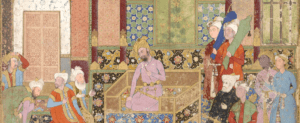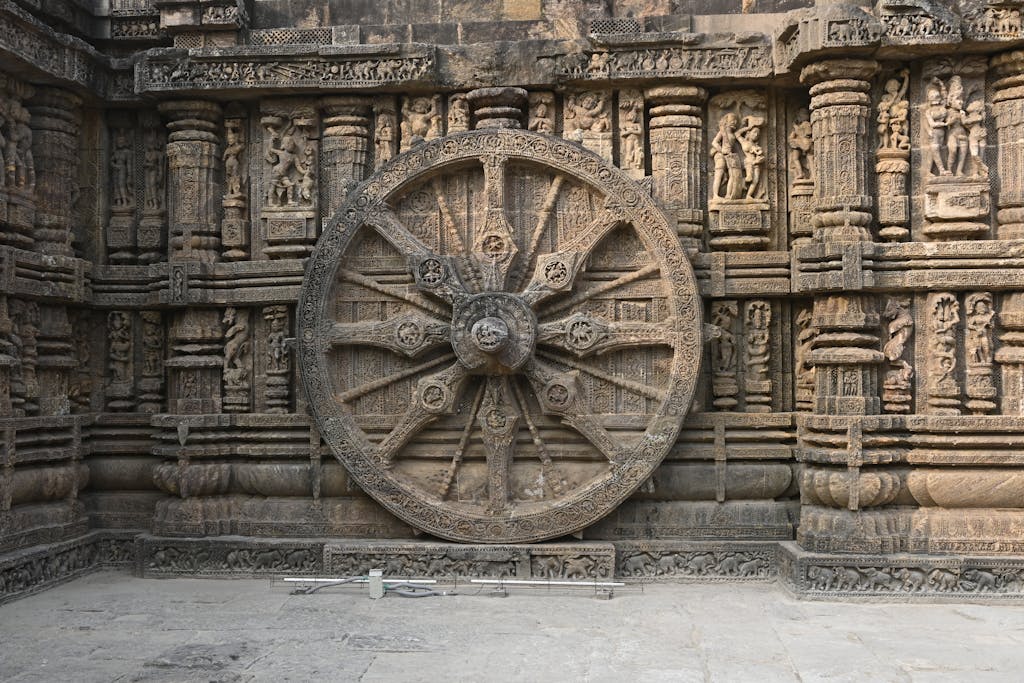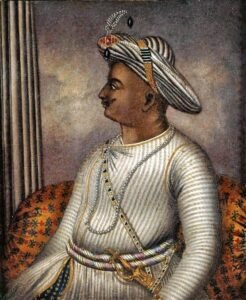
The Taj Mahal, located in Agra, India, is one of the most magnificent monuments in the world, recognized universally as a symbol of eternal love. Commissioned by Mughal Emperor Shah Jahan in memory of his beloved wife, Mumtaz Mahal, it has stood the test of time for nearly 400 years as an icon of both architectural brilliance and profound emotional devotion.
With its ethereal white dome floating above lush gardens, it captivates millions of visitors each year. Yet, behind its radiant beauty lies a story of immense human sacrifice, painstaking artistry, and architectural brilliance that pushes the limits of human creativity. This is a monument where love and sorrow intertwine, a lasting testament to Mughal Emperor Shah Jahan’s devotion to his beloved wife, Mumtaz Mahal.
Let’s journey into the depths of this masterpiece — from the smallest gemstone embedded into its walls to the human lives lost in its construction — to truly understand why the Taj Mahal is not merely a building but a pinnacle of human expression.
1. Historical Context and Purpose of the Taj Mahal
The story of the Taj Mahal begins with a profound personal loss. Mumtaz Mahal, the wife of Shah Jahan, died in 1631 during the birth of their 14th child. Overwhelmed by grief, Shah Jahan pledged to build a monument that would serve as an eternal testament to his love for her.
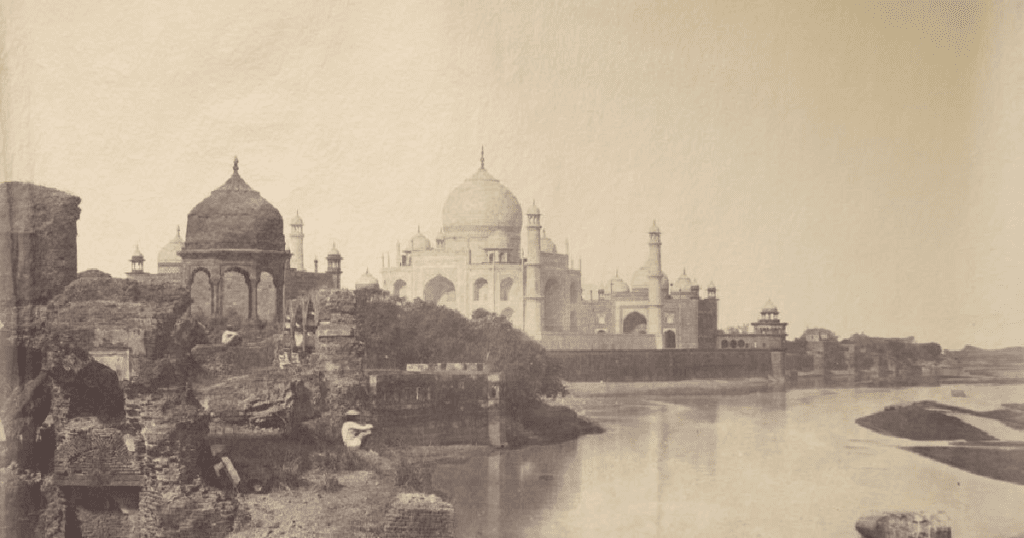
Shah Jahan envisioned the Taj Mahal as more than just a tomb. It was to be a metaphor for Jannat, the Islamic concept of paradise. Every element of the structure, from the towering minarets to the lush Charbagh (four-part) gardens, symbolized eternal paradise — a place where he hoped his beloved would reside for eternity. His obsession with detail and perfection would later result in an architectural wonder, but not without immense cost.
2. The Architecture and Layout of the Taj Mahal Complex
The Taj Mahal complex spans an area of 42 acres, meticulously designed in line with Mughal architectural traditions, which incorporate Islamic, Persian, and Indian elements. The symmetry, grandeur, and ornamentation reflect both the architectural ambitions of the Mughal Empire and its deep spiritual symbolism.
2.1 The Layout of the Complex
The layout of the Taj Mahal follows a typical Charbagh design, a Persian-style garden layout divided into four sections by walkways and water channels, representing the four rivers of paradise in Islamic cosmology.
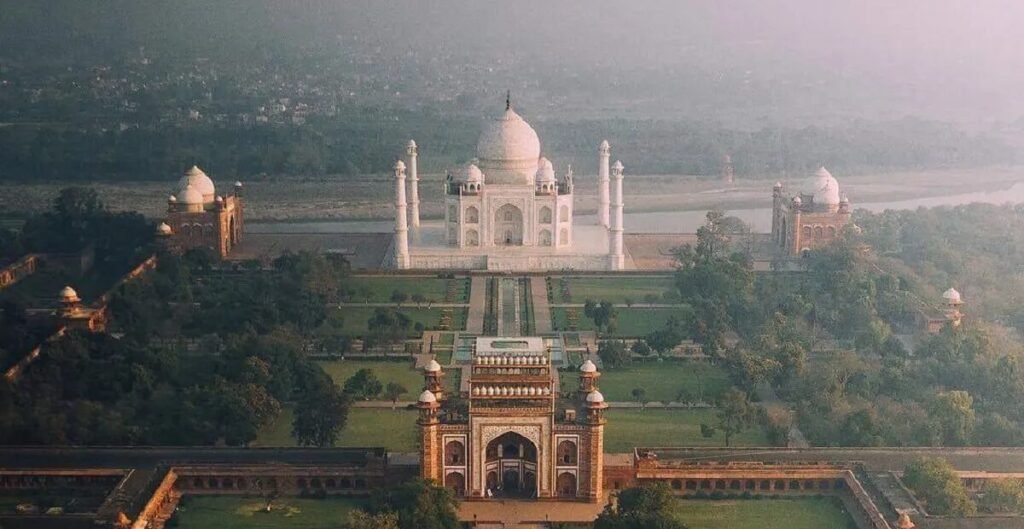
Entrance Gate (Darwaza-i Rauza)
The journey through the Taj Mahal complex begins with a grand entrance gate (the Darwaza-i Rauza) made from red sandstone. The gate is massive, adorned with elaborate calligraphy of verses from the Quran. Standing at nearly 30 meters high, it sets the tone for the grandeur that lies beyond.
The large central arch of the gate is flanked by smaller arches, and its walls feature intricate pietra dura work (stone inlay) and marble lattice screens that allow light to filter in subtly, heightening the visitor’s anticipation.
The Charbagh Gardens
Once inside, visitors encounter the expansive Charbagh gardens. The geometric precision of the garden layout, divided by four water channels, mirrors the Islamic concept of paradise. These gardens are filled with lush greenery and flowering plants, with a long reflecting pool that creates a stunning mirrored image of the Taj Mahal.
2.2 The Main Mausoleum
At the heart of the complex lies the main mausoleum, a gleaming structure built entirely of white Makrana marble. The mausoleum sits atop a raised marble platform and is crowned by its iconic onion dome, one of the largest in the world, rising to a height of 73 meters (240 feet).
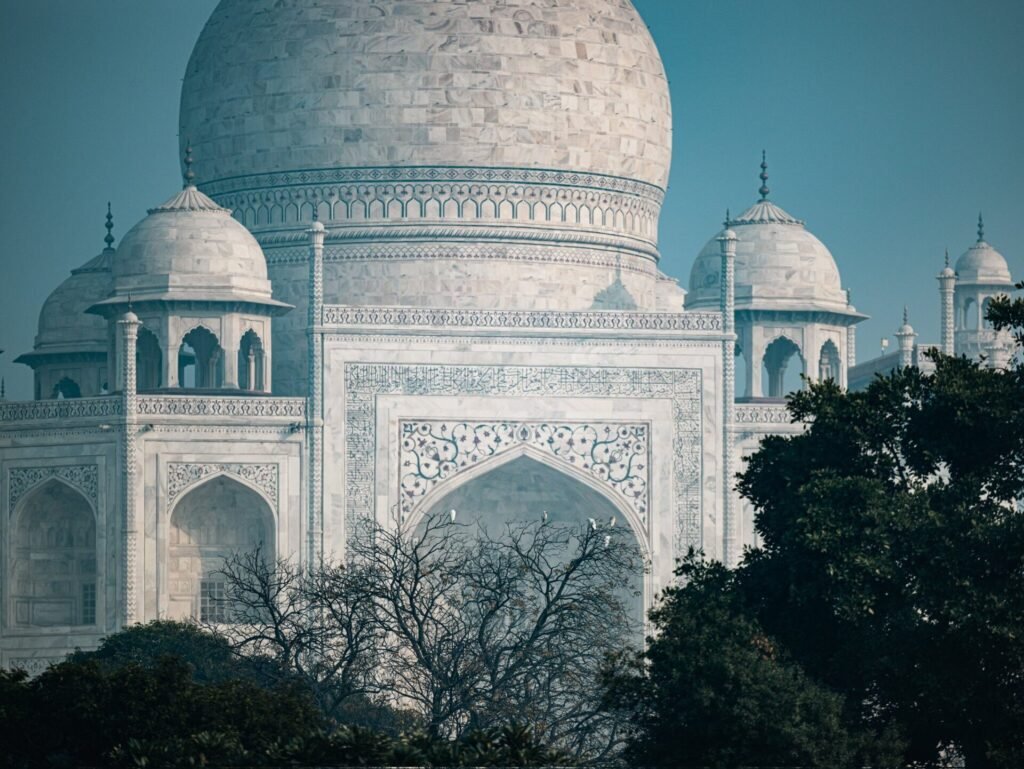
The Grand Dome: Crown of the Taj Mahal
The Taj Mahal’s central dome, often referred to as its “onion dome”, gives the Taj Mahal its signature silhouette is one of the largest of its kind, standing at about 73 meters (240 feet) high. This double-shell dome was a revolutionary feature of Mughal architecture, offering structural strength while maintaining the illusion of weightlessness. Surrounding this central dome are four smaller domes, contributing to the monument’s balanced design.
Inside the dome, the acoustics create an echo chamber that enhances the spiritual aura of the space, adding a mystical quality to the experience of those who enter the mausoleum.
The Minarets
The dome is flanked by four smaller domes and surrounded by four tall minarets, each standing about 40 meters (131 feet) tall. These minarets are slightly tilted outward, an intentional design to ensure that, in the event of an earthquake, they would fall away from the central structure, protecting the tomb beneath.
Exterior Walls and Carvings
The walls of the Taj Mahal are a masterpiece of ornamentation, featuring:
- Calligraphy: Verses from the Quran adorn the arches, gracefully rendered by Amanat Khan, the chief calligrapher. The black marble inscriptions are not only beautiful but were designed with an optical illusion: the size of the letters increases as they ascend, ensuring the calligraphy appears uniform from the viewer’s perspective.
- Pietra Dura Inlay: The walls are intricately decorated with pietra dura, a technique where semi-precious stones such as lapis lazuli, jade, jasper, and turquoise are embedded into the marble to form elaborate floral patterns, arabesques, and geometric designs. This level of detail represents the pinnacle of Mughal craftsmanship.
- Floral Motifs: The floral designs were inspired by the gardens of paradise, and motifs like tulips, lilies, and irises are prevalent. These designs are symbolic of life, death, and resurrection, key themes in Islamic culture.

2.3 The Interior of the Mausoleum
The interior of the Taj Mahal is designed to reflect the celestial beauty of Jannat (paradise). The focus of the interior is the central chamber, which houses the cenotaphs of Mumtaz Mahal and Shah Jahan. However, these are symbolic graves; the actual tombs lie in a crypt beneath the main chamber.
The Cenotaphs and Marble Screens
- Mumtaz Mahal’s cenotaph is centrally placed, surrounded by an elaborately carved marble screen or jali. The marble screen features delicate latticework, designed to give the space an airy, ethereal feel.
- Shah Jahan’s cenotaph, added later after his death, is positioned to the side, slightly disrupting the original symmetry of the design.
The cenotaphs themselves are adorned with intricate inlay work, featuring floral motifs made of precious and semi-precious stones. Quranic verses and the 99 names of Allah are inscribed on both cenotaphs, reinforcing the spiritual and eternal nature of the monument.
3. Other Structures Within the Complex
While the white marble tomb is the centerpiece, the Taj Mahal complex includes several other significant structures, each contributing to the grandeur of the entire site.
3.1 The Mosque
To the west of the Taj Mahal stands a mosque made of red sandstone, a typical Mughal feature for royal mausoleums. This mosque was designed not only for religious purposes but to sanctify the complex, ensuring that it was a place of worship and reflection.
The mosque features three domes and a large prayer hall, with mihrabs (prayer niches) pointing towards Mecca. Its walls are similarly adorned with Quranic verses and intricate carvings, though in a more understated style compared to the main mausoleum.
3.2 The Mehmaan Khana (Guest House)
Mirroring the mosque on the eastern side of the complex is the Mehmaan Khana (guest house), built symmetrically to maintain balance in the complex’s layout. While its purpose remains somewhat ambiguous, it is believed to have been used to accommodate important guests and officials who visited the Taj Mahal. The building’s architecture echoes the mosque, though it lacks religious features such as mihrabs.
4. Materials, Stones, and Artistic Techniques
The Taj Mahal’s allure lies not only in its design but also in the materials used and the extraordinary craftsmanship that went into its construction.
4.1 Makrana Marble
The primary material used in the Taj Mahal is Makrana marble, sourced from Rajasthan. This marble is prized for its purity and its ability to reflect light. It is this quality that gives the Taj Mahal its famous glow, which changes depending on the time of day. At sunrise, it appears pinkish, during the day, dazzling white, and under moonlight, it takes on a bluish hue.
4.2 Pietra Dura
The pietra dura technique, brought from Persia and perfected by Mughal artisans, is a hallmark of the Taj Mahal. This stone inlay work is most visible in the floral designs, where semi-precious stones such as carnelian, jasper, lapis lazuli, and jade are embedded into the marble to create stunningly intricate patterns. The brilliance of the stones adds a level of luxury and artistry to the monument, reflecting the grandeur of the Mughal Empire.
4.3 Calligraphy and Marble Screens
The calligraphy adorning the walls of the Taj Mahal was executed with incredible precision and care. The verses chosen from the Quran are rendered in thuluth script, and the varying size of the letters creates an optical illusion of uniformity.
The marble screens, or jali work, within the mausoleum are another testament to the skills of the artisans. Each screen is carved with such delicacy that it appears almost lace-like, allowing light to filter through and cast gentle shadows on the interior surfaces, enhancing the ethereal quality of the space.
5. Construction and Engineering Marvels
5.1 Labor Force and Artisans
To bring Shah Jahan’s vision to life, an estimated 20,000 workers were employed over the course of 22 years. These included skilled craftsmen, stonecutters, calligraphers, masons, and artisans from India and neighboring regions such as Persia, the Ottoman Empire, and Central Asia. A significant number of Rajputana (Rajasthani) artisans were involved, particularly in the marble carving and inlay work.
5.2 Engineering and Symmetry
The engineering feats involved in the Taj Mahal’s construction are extraordinary. The entire structure rests on a massive plinth, and the weight distribution of the central dome and surrounding minarets is so precise that it has stood without significant damage for centuries. The minarets, slightly angled outward, are an ingenious precaution to protect the tomb from potential collapse during an earthquake.

The complex’s symmetry is another defining feature, with every structure meticulously balanced along the central axis. The positioning of the mosque and guest house on either side of the mausoleum creates a harmonious balance, reflecting Mughal principles of order and proportion.
6. Origins of the Taj Mahal’s Design and the Human Cost
Though Shah Jahan is universally credited with the Taj Mahal’s creation, the identities of its architects remain largely unknown due to the Islamic tradition of attributing grand projects to rulers rather than individual designers.
- Shah Jahan was deeply involved in its construction, holding daily meetings and making personal alterations to the designs.
- Historical records mention Ustad Ahmad Lahauri and Mir Abd-ul Karim as key figures in overseeing the project, though a large team of artisans and craftsmen contributed.
The construction spanned 22 years and involved a workforce of 20,000 laborers, including masons from India, inlay artisans from Persia, and calligraphers from Iran. The harsh conditions led to high mortality rates, with workers subjected to intense labor, extreme heat, and hazardous materials. Legends of Shah Jahan maiming workers to prevent them from replicating the Taj’s beauty, though likely myth, underscore the brutal atmosphere surrounding its creation.
The project’s financial cost—around 32 million rupees—also placed a heavy burden on the Mughal treasury, contributing to the Mughal empire‘s eventual decline.
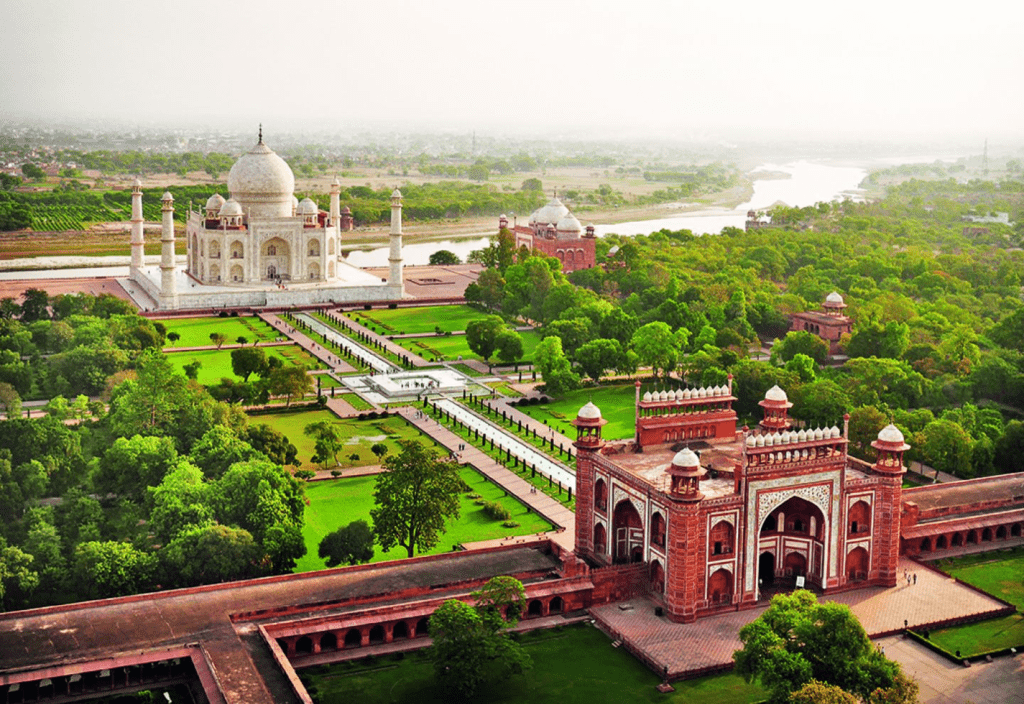
The Taj Mahal is more than just a mausoleum; it is an enduring symbol of love, loss, and Mughal architectural genius. From its carefully crafted inlays and flawless symmetry to the intricate calligraphy and symbolic gardens, every element of the Taj Mahal was designed with precision and purpose. The materials used, such as the Makrana marble, and the sheer scale of craftsmanship involved, make the Taj Mahal a marvel of art and engineering. Today, it stands as a UNESCO World Heritage Site, a beacon of India’s rich cultural history, and a source of wonder for millions of visitors from around the world.

